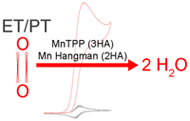Publication
861
ACS Catal., 8 (9), 8671-8679, 2018
DOI:10.1021/acscatal.8b01944
|
|
|
|
|
|

|
Oxygen Reduction Reaction Promoted by Manganese Porphyrins
|
|
|
|
Guillaume Passard, Dilek K. Dogutan, Mengting Qiu, Cyrille Costentin, and Daniel G. Nocera
Department of Chemistry and Chemical Biology, Harvard University, Cambridge, Massachusetts 02138, USA
Laboratoire d'Electrochimie Moléculaire, Unité Mixte de Recherche Université – CNRS N° 7591, Bâtiment Lavoisier, Université Paris Diderot, Sorbonne Paris Cité, 15 rue Jean de Baïf, 75205 Paris Cedex 13, France
The oxygen reduction reaction (ORR) is catalyzed by manganese(II) porphyrins in the presence of Brønsted acids (HAs). Analyses of the catalytic cyclic voltammetric profiles have permitted the ORR mechanism to be constructed and rate constants to be extracted for both the formation of the initial oxygen adduct and the O–O bond cleavage event for a series of HAs. The dependence of the formation rate constant of the oxygen adduct on reactant concentrations reveals a rate law that is first order in Mn porphyrin and oxygen substrate. A second order dependence in HA is observed for unadorned Mn porphyrin platforms whereas with Mn hangman porphyrin, a proton is provided intramolecular to the oxygen adduct and consequently the HA order is reduced to unity. The stabilization of the oxygen adduct with an additional hydrogen bond from HA engenders a rate-determining step involving O–O bond cleavage, resulting in the rare instance where the activation of the O–O bond is directly observed. |

